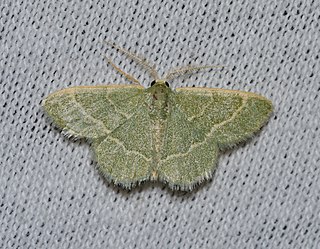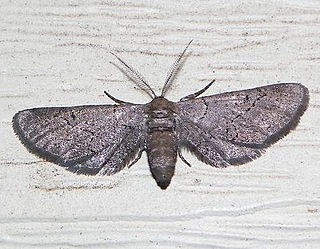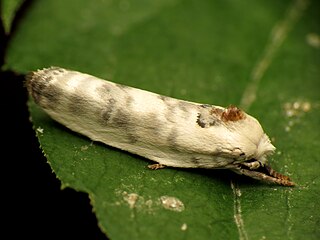Related Research Articles

The peppered moth is a temperate species of night-flying moth. Peppered moth evolution is an example of population genetics and natural selection.

The de Havilland Gipsy Major or Gipsy IIIA is a four-cylinder, air-cooled, inverted inline engine used in a variety of light aircraft produced in the 1930s, including the famous Tiger Moth biplane. Many Gipsy Major engines still power vintage aircraft types worldwide today.

The cinnabar moth is a brightly coloured arctiid moth found as a native species in Europe and western and central Asia. It has been introduced into New Zealand, Australia and North America to control ragwort, on which its larvae feed. The moth is named after the red mineral cinnabar because of the red patches on its predominantly black wings. The species was first described by Carl Linnaeus in his 1758 10th edition of Systema Naturae. Cinnabar moths are about 20 mm (0.79 in) long and have a wingspan of 32–42 mm (1.3–1.7 in).

The bogong moth is a temperate species of night-flying moth, notable for its biannual long-distance seasonal migrations towards and from the Australian Alps, similar to the diurnal monarch butterfly. During the autumn and winter it is found in southern Queensland, western New South Wales, western Victoria, and also in South and Western Australia. Adult bogong moths breed and larvae hatch during this period, consuming winter pasture plants during their growth. During the spring, the moths migrate south or east and reside in mountains such as Mount Bogong, where they gregariously aestivate over the summer until their return towards breeding grounds again in the autumn.

Saturnia pavonia, the small emperor moth, is a moth of the family Saturniidae. It was first described by Carl Linnaeus in his 1758 10th edition of Systema Naturae. Sometimes, the incorrect genus name Pavonia is still used for this species. This moth occurs throughout the Palearctic region and is the only member of its family to be found in the British Isles, where it is usually called simply the emperor moth.

Vigna aconitifolia is a drought-resistant legume, commonly grown in arid and semi-arid regions of India. It is commonly called mat bean, moth bean, matki, Turkish gram or dew bean. The pods, sprouts and protein-rich seeds of this crop are commonly consumed in India. Moth bean can be grown on many soil types, and can also act as a pasture legume.

Gracillariidae is an important family of insects in the order Lepidoptera and the principal family of leaf miners that includes several economic, horticultural or recently invasive pest species such as the horse-chestnut leaf miner, Cameraria ohridella.

Athrips mouffetella is a moth of the family Gelechiidae. It is found from central and northern Europe to the Ural Mountains, Siberia and the Russian Far East. It has also been recorded from North America.

Coleophora trochilella is a moth of the family Coleophoridae. It is found in all of Europe, with possible exception of parts of the Balkan Peninsula.

Coleophora tanaceti is a moth of the family Coleophoridae. It is found from Spain, north to Fennoscandia, east to the Baltic region, south to Italy and Bulgaria. It has also been recorded from the Near East.

Coleophora versurella is a moth of the family Coleophoridae. It was described by Philipp Christoph Zeller in 1849.
Dichomeris acuminata, the alfalfa leaf tier, is a moth of the family Gelechiidae. It was first described by Otto Staudinger in 1876. It is a widely distributed species, being known from India, Myanmar, and Sri Lanka southwest to the Seychelles, Mauritius and Réunion and on to Egypt, east and South Africa and southern Europe. Eastward from India it extends through Indonesia and Malaysia to Taiwan and Australia. It is also found in Japan, the West Indies, North America and Hawaii.
Athrips rancidella, the cotoneaster webworm, is a moth of the family Gelechiidae. It is found in most of Europe, except Ireland, the Netherlands, Fennoscandia and the Baltic region. It has also been recorded from Syria, Turkmenistan, Tajikistan and the United States.

Chionodes fumatella, the downland groundling, is a moth of the family Gelechiidae. It is found in almost all of Europe. Outside of Europe, it is found in Turkey, the Caucasus, Mongolia and from Siberia to the Russian Far East.
Archips fuscocupreanus, the exotic leafroller moth or apple tortrix, is a species of moth of the family Tortricidae. It is found in China, South Korea, Japan and Russia. It is an introduced species in the north-eastern United States, where it has been recorded from Connecticut, Massachusetts, New Jersey, New York and Rhode Island. It has also been recorded from Washington.

Periclepsis cinctana, the Dover twist, is a species of moth of the family Tortricidae. It is found in most of Europe, where it has been recorded from Spain, Great Britain, the Benelux, Germany, Denmark, Italy, Switzerland, Austria, the Czech Republic, Slovakia, Slovenia, Poland, Hungary, Bulgaria, Romania, North Macedonia, Norway, Sweden, the Baltic region and Russia. The habitat consists of chalk downlands and calcareous grasslands.

Aroga trialbamaculella, the red-striped fireworm moth, is a moth of the family Gelechiidae. It is found in the United States, where it has been recorded from Maine to Florida and from Illinois to Texas.

Chlorochlamys phyllinaria, the thin-lined chlorochlamys moth, is a moth of the family Geometridae. It is found in North America, where it has been recorded from Georgia to California, northward in the central states to Nebraska.

Exelis pyrolaria, the fine-lined gray moth or plumose gray moth, is a species of moth in the family Geometridae. It is found in North America, where it has been recorded east of the Mississippi River and south of Illinois and the District of Columbia.

Antaeotricha leucillana, the pale gray bird-dropping moth, is a moth in the family Depressariidae. It was described by Philipp Christoph Zeller in 1854. It is found in North America, where it has been recorded from New Hampshire, Massachusetts, New York, Pennsylvania, District of Columbia, Virginia, North Carolina, Georgia, Alabama, Arkansas, Missouri, Kansas, Illinois, Iowa, Texas, Oregon, Louisiana, Manitoba and Nova Scotia.
References
- ↑ "GlobIZ search". Global Information System on Pyraloidea. Retrieved 2014-07-15.
- ↑ Moth Photographers Group at Mississippi State University
- ↑ Bug Guide
| This Petrophila-related article is a stub. You can help Wikipedia by expanding it. |